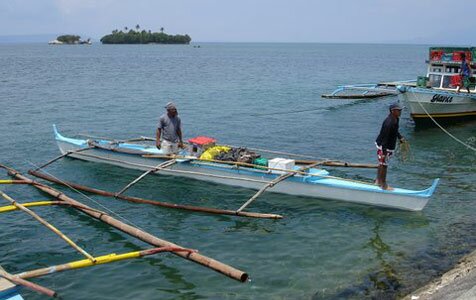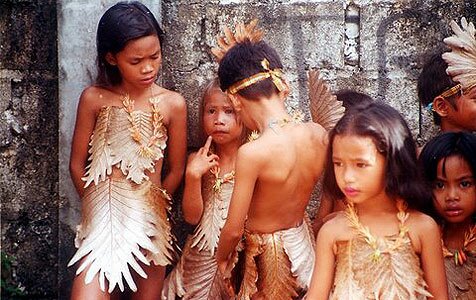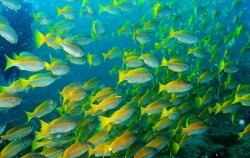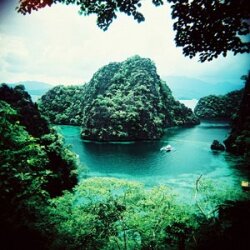Last Frontiers: Philippines
From Microcosm Aquarium Explorer

- Flying into the Philippines' last frontier: Coron, Palawan. Alexandra Didoha
- Jeepney gets you from the airport to town. Judy Didoha
- A typically fisherman's home. Alexandra Didoha

- Plywood and bamboo bancas used by local fishermen. Alexandra Didoha

- Tagbanua children in native costumes at annual fiesta. Alexandra Didoha
A hidden treasure among the Philippines’ 7,000 islands
Finding shimmering blue water with a backdrop of coral reefs is an easy feat when traveling to the Philippine archipelago. The hard part is deciding where to stop.
Each of the 7,000 islands that comprise the Philippines offers something unique; it may be the rare Blueface Angelfish, the delicious Guimaras mango, the local Tagbanua dialect, or the incredible sighting of the almost-perfect cone of the volcano, Mayon.
I have lived and traveled throughout the country for over seven years, first as a Peace Corps volunteer and later as a marine biology researcher, and still my favorite spot is Coron, which is nestled near the northern tip of the Philippine’s last frontier, Palawan.
[edit] A Long Hop and a Jeepney Ride
A one-hour ride in a propeller-driven airplane or a 13-hour boat ride from Manila will get you to Coron, the island I think of as the Philippines' last frontier.
My favorite approach is the plane flying you over lush green islands surrounded with white sand beaches. If you take the plane you have the added adventure of a 45-minute bumpy jeepney ride to town from the airport.
Jeepneys are one of the most popular forms of public transportation in the Philippines and are constructed from leftover World War II jeeps. Traveling aboard a jeepney is an essential must for any Philippine vacation. Inside the jeepney you will have the opportunity to pass your fare forward along a line of travelers sitting face-to-face on a wooden bench, and yell Pare! (Stop!) to inform the driver he has arrived at your destination.
Upon arriving in Coron you will experience a busy downtown with loud buzzing of motorized tricycles whizzing in all directions. Tricycles are the most common public transportation in Philippine small islands, and they are made of motorcycles attached to a small two-seater side car.
You will be amazed at how many people can ride a tricycle, the most I have seen was 10 Filipinos hanging from every part of the tricycle; I was amazed it could even move forward.
From Coron, interesting adventures await on this island for any world traveler, from wreck diving, island kayaking, soaking in hot springs, lake hiking, to tramping through a wildlife preserve for African animals.

[edit] Eerie Shipwreck
Within the waters of Coron lies a rare opportunity for any diver: the chance to dive ten sunken World War II Japanese Shipwrecks.
My first exposure to wreck diving was in Coron on the Japanese tanker, Okikawa Maru. A fellow Peace Corps volunteer and I were dropped off in the water by my Filipino host agency. My Philippine coworkers stayed aboard the boat because they did not know how to swim (something that I found surprising but that turns out to be extremely common throughout the Philippines) and told us, "Swim North."
We did as instructed and for what felt like miles underwater, and I could make out nothing in the water. Then all of the sudden, boom, we were right on top of the ship. My heart skipped a beat realizing that this massive dark shape was the bombed Japanese tanker that sank in 1944. A sensation of being in a very eerie place swept over me.
Whatever tragic end people had met here was now marked by beautiful soft colt corals twirling with the current on the bow of the wreck, while schools of Yellow Snapper cruised past.

The resident Coral Grouper, referred to in Tagalog as Lapu-lapu, made his expected appearance as I drifted along the bottom. Lapu-lapu is a favorite fish among Filipinos and tastes absolutely delicious any way it is cooked.
We surfaced 45 minutes later to find my Filipino coworkers eating rice and fish with their hands. They smiled and asked us if we caught any dinner. Okikawa Maru is a great wreck for beginning divers as it is relatively shallow at 10-15 meters (33-50 ft). The other nine shipwrecks in Coron are for the more experienced diver, ranging from 35-50 meters (115-165 ft) depth and with opportunities for deep penetration inside the engine rooms if you have the skills and this appeals to you.
[edit] Kayaking, Hiking, and Camping in Kayangan
Standing on the pier of Coron and looking into the open sea you see an island several miles away with huge limestone cliffs. The water surrounding the island is glistening blue and bordered with white sand, this is Kayangan Island.
For months I would look out from the pier during my Peace Corps service and dream of kayaking to Kayangan but could not find any Filipinos to join me. They thought it was bizarre I wanted to kayak and camp on the island that is home to the indigenous tribe, the Tagbanua.
Then, on my birthday, I convinced my friends to join me on a kayaking trip which was part of my “blow-out.” “Blow-out” in Filipino tradition means birthday party, the only catch is you give the party for yourself and invite all your friends. We rented kayaks from the local tourism shop and hired a small wooden pump boat (banaca) equipped with bamboo outriggers and a lawn mower engine to bring us to Kayangan.
We loaded the bright yellow kayaks aboard the banaca and puttered slowly to the island. They dropped us off and kept confirming that we did not need a ride back to town and that we were going to paddle. I reassured them numerous times, but they were still in disbelief that we were going to paddle back let alone sleep on this island. As we got situated in our kayaks and began to paddle I was awestruck.

Our backdrop was crystal clear blue water with swiftlet birds flying between the cliffs, these images appeared to be direct from a National Geographic movie. I had to pinch myself to believe this was real. My friends hollered at me as they rounded the corner, shouting, ingoy! ingoy! which is Tagalog for monkey. And there three macaca monkeys were sitting along the shoreline staring at the bright yellow boats passing by with equal curiosity.
We paddled for several hours until we reached an area to view Kayagan. At the entrance to Kayangan Lake we tied up our kayaks and ascended 700 stone stairs. I was panting heavily up the steep stairs and when I reached the top, there it was, almost a hundred feet below, gorgeous turquoise water sparkling with the sun and surrounded with mile-high white limestone cliffs.
We descended the remaining 300 stairs into the lake and hopped in for a swim. I was cautioned by my friends to remain quiet as a sign of respect for the Tagbanua, since Kayangan Lake is considered a sacred place of the tribe.
The Tagbanua make a livelihood from the collection of swiftlet bird nests found high in the limestone cliffs. Daily, the men ascend the cliffs with no protection, not even a rope, to collect the nests which will later be sold for a small sum in the town market. These nests are exported to Manila and China and sold for hundreds of dollars and made into the Chinese delicacy, Bird Nest Soup.
Refreshed by the dip in the volcanic lake, we retraced our steps to our kayaks and paddled towards the eastern part of the island where we set up camp for the night. I cooked a birthday meal of Magi Noodles (Ramen) for everyone, and as the sky grew dark, we all lay down to rest on the white sand beach covered with my bamboo mat and mosquito net.
I looked up through my net and saw the dark sky filled with millions of stars and thought: "What a perfect “birthday-blow-out."
[edit] Visitor Information
Food and lodging in the Philippines can be exceptionally affordable. Getting there is more expensive: travel to the Philippines currently ranges from $1,000-$2,500 dollars roundtrip, for North American residents.
Northwest Airlines (www.nwa.com) is the major carrier for travel from the United States to the Philippines.
Airline travel to Coron from Manila is through one of two airlines, South East Asian Airline (www.flyseair) or Asian Spirit (www.asianspirit.com). If you prefer the 13 hour journey by ship, there is the Super Ferry (www.superferry.com.ph).
Diving, Kayaking, and Where to Stay
Not all Philippines reefs are degraded by dynamite and cyanide fishing. Some are in beautiful shape: State of the Reefs: Philippines I
This all can be done at my favorite place, Sea Dive Resort (http://www.seadiveresort.com). Sea Dive has excellent prices, clean rooms, good food, and an owner who was a former Peace Corps Volunteer in the Philippines.
Further reading:
Okika Maru Wreck
Travel Philippines
Map & Species List
Tommy Schultz' Underwater Palawan Photos
Alexandra V. Didoha is studying marine biology at Florida Institute of Technology, Melbourne, FL. See Also: Tracking the Elusive Flagfish.








